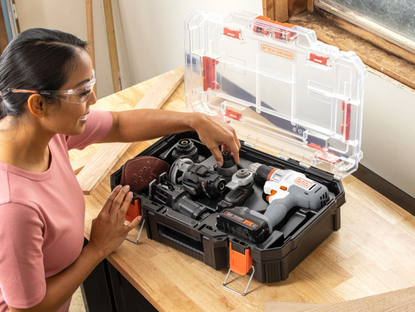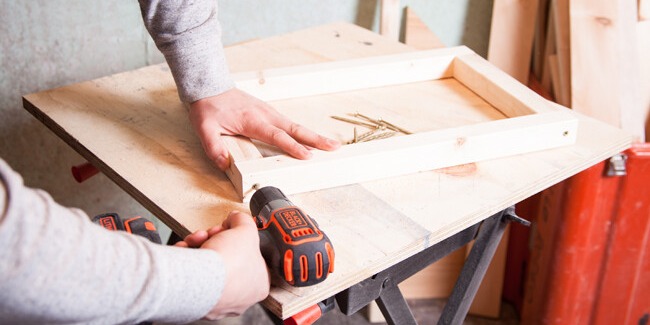DIY bathroom standing shelves

Skill Level: Beginner | Estimated Time: 6 hours + dry time
Instead of storing your towels and other bath items in a hall closet, keep them within easy reach in a DIY shelving unit.
This five-shelf design can be built in one afternoon and features shelves that are slatted with a ½" gap between slats for ventilation. The bottom shelf is 7" high to keep towels off the damp floor (and allow for easy cleaning underneath).
Things You’ll Need

Step by Step Instructions
Step 1. Cut the Pieces
Use your BLACK+DECKER 20V MAX* 5-1/2 in. Circular Saw to cut the following pieces from the 2 x 2” boards:
- (4) pieces, 72” long for the legs
- (10) pieces, 18” long for shelf support fronts
- (10) pieces, 10” long for shelf support sides
Also cut (35) pieces of 1/2 x 2” lattice molding, 14” long for the shelf slats.

Tip: Use S4S lumber for the slats if you can't find lattice molding. S4S means that it's sanded on all four sides.
Step 2. Sand Everything
Sand everything smooth with the BLACK+DECKER MOUSE® Detail Sander and 120-grit sandpaper. Round over all the corners and edges so they are smooth and free of splinters.

Step 3. Pre-Drill Pilot Holes in the Shelf Slats
Use your BLACK+DECKER 20V MAX* Lithium Drill/Driver with AutoSense™ Technology and a 1/8” bit to drill two pilot holes in both ends of each slat. Space the holes equally, centering them 1” from the end of the slat.
Tip: Pilot holes should be just slightly smaller than the diameter of the screw to prevent splitting the wood. The holes should be small enough to allow the screw threads to grip tightly.
Step 4. Assemble the Shelf Supports
Place two of the 18” shelf supports parallel to each other 1’ apart. Apply glue to the ends of two 10” shelf supports and place these between the 18” supports. Drill two pilot holes through the 18” pieces using a 1/8” bit. Fasten the joints with 3 1/2” screws to form a 14 x 18” rectangle. Repeat this process to assemble the remaining four shelf supports.
Step 5. Add the Slats
Apply glue to the ends of two slats one at a time, covering a 1” square area on both ends. Starting at both sides of a shelf support frame, place the slats perpendicular to the 18” sides of the frame so the slats are flush to the outsides of the frame. Drive 1 1/4” screws through the pilot holes in the slats to secure them to the rectangle. Install five more slats in between the two outer slats, spacing them about 5/8” apart. Repeat the same process to complete all five shelves.
Tip: Cut 5/8” wide spacer blocks from scrap wood to place between slats for easy layout.
Step 6. Mark the Shelf Positions
Place all four 72” legs on a flat surface, parallel to each other and flush at the ends. Measuring down from the top end of one leg, make a mark every 16” for a total of four marks. Use a carpenter’s square and pencil to draw a line across all four legs at each mark to indicate the centers of the shelves. Pick up each leg and use the square to continue each line all the way around the leg.
Tip: The top shelf will be flush with the top ends of the legs, so you don't need marks for this shelf.
Step 7. Assemble the Shelves + Two Legs
Place two of the legs parallel to each other on a flat surface, 14” apart. Apply glue to the top faces of the legs at one of the shelf locations, using the lines for reference. Set a shelf on top of the legs so the 18” shelf support is against the legs and is centered on the shelf's location lines. The outside edges of the shelf should be flush with the outsides of the legs.
Drill a pilot hole through the 18” shelf support, angling the hole toward the center of the leg. Center the hole on the shelf support so you don't run into the screws of the support-frame joint. Fasten the support to each leg with a 3 1/2” wood screw. Repeat the same process for each shelf.
Step 8. Add the Remaining Legs
Place the other two legs parallel, 14” apart, on a flat surface. Apply glue to the shelf lines as before. Pick up the half-assembled unit, turn it upside down and place it on top of the two legs. Line up the shelves with the marked lines. Drill angled pilot holes and fasten the shelves to the legs with 3 1/2” screws.
Step 9. Seal + Protect
Apply stain with a soft cloth and allow it to dry according to the manufacturer’s recommended dry time. Spray on a light coat of aerosol lacquer and allow it to dry as directed. Sand everything with 180-grit sandpaper by hand, and spray on one more coat of lacquer.



















